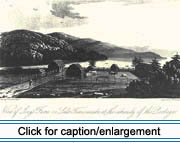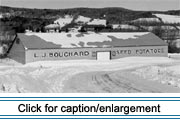|
 Farming
has been the principal occupation of the Upper St. John Valley since its
early settlement. The clearing and cultivation of the flats along the
river was the primary focus during the first decades of settlement. Yet,
agricultural yield was far from stable in those early years. The year
1797 is known in area history as "l'année de la misére noire" or
"year of the great famine" because of an early frost and harsh winter
that destroyed the crops and caused many deaths in the community (Albert
[1920] 1985: 56). With a frost-free season of only 108 days, the Upper
St. John Valley is particularly prone to late frosts in the spring and
early frosts in the fall. Apart from the great tragedy of 1796, there
were also major crop failures in 1816, 1817, 1828, 1829, 1833, and 1840
(Craig 1988: 129). Farming
has been the principal occupation of the Upper St. John Valley since its
early settlement. The clearing and cultivation of the flats along the
river was the primary focus during the first decades of settlement. Yet,
agricultural yield was far from stable in those early years. The year
1797 is known in area history as "l'année de la misére noire" or
"year of the great famine" because of an early frost and harsh winter
that destroyed the crops and caused many deaths in the community (Albert
[1920] 1985: 56). With a frost-free season of only 108 days, the Upper
St. John Valley is particularly prone to late frosts in the spring and
early frosts in the fall. Apart from the great tragedy of 1796, there
were also major crop failures in 1816, 1817, 1828, 1829, 1833, and 1840
(Craig 1988: 129).
By the 1820s, the premier rangs of Acadian farmers were well established
and prepared to supply the developing needs of the timber industry. Local
farm produce during the 19th century supplied most of the needs of the
Valley population--vegetables, potatoes, buckwheat, oats, hay, sheep,
hogs, and dairy products. There were sizable surpluses left after the
Valley residents met their own needs. Established farms tended to be very
productive, more productive than average New England farms (Craig 1993b).
In the early 1830s farmers concentrated on growing wheat, encouraged
by provincial bonuses. According to J. Bouchette, the surveyor of Lower
Canada, the St. John Valley residents were making a handsome profit selling
flour downriver. The wheat boom was short lived. A short growing season,
combined with the midge that was ravaging New England and Lower Canada,
killed the potential of this crop. Therefore, Valley farmers switched
to other crops: oats and hay, primarily for lumber camps, and foodstuffs
such as potatoes and buckwheat that they could sell to families clearing
new land (one-third of Valley households in any given year till the end
of the century). A degree of socioeconomic stratification resulted as
some farmers reaped the profits of well-developed farms while others were
preparing new ground to plow (Craig 1993a; 1993b).
|
 |
 |
 Farming
in the Upper St. John Valley has traditionally been labor-intensive, particularly
the hand-picking of potatoes, and the Maine Acadian family was instrumental
in developing Valley farmland and ensuring continued production. The needed
workforce was provided primarily by the immediate family, though a tight
knit extended-family network could be called upon during times of need.
Immediate families (father, mother, and offspring) tended to be large
throughout the 19th century and most of the 20th. Two elder residents
of the Valley described their lives caring for a large family, and during
harvest season (focus group 1993): Farming
in the Upper St. John Valley has traditionally been labor-intensive, particularly
the hand-picking of potatoes, and the Maine Acadian family was instrumental
in developing Valley farmland and ensuring continued production. The needed
workforce was provided primarily by the immediate family, though a tight
knit extended-family network could be called upon during times of need.
Immediate families (father, mother, and offspring) tended to be large
throughout the 19th century and most of the 20th. Two elder residents
of the Valley described their lives caring for a large family, and during
harvest season (focus group 1993):
I had a big family. Ten kids. I've got 47 grandchildren and 16 great-grandchildren.
And all I did with my life is stay home with my kids and work, and work,
and more work. You know, canning and making gardens. Well, all along
the Valley, it's mostly the same. Cooking . . . when you don't cook,
you wash; if it isn't clothes you're washing, you're washing kids. And
if you're not washing kids, you're washing walls. (Pauline Doucette)
Farms . . . picking potatoes. . . . You'd get home and you'd be
so tired. And I was quite a picker. . . . And I'd go home and go to
bed right after supper, and I'd pick potatoes all night long. (Rolande
Levesque)
 Today,
the hand-harvest of potatoes continues at only a few farms. Following
Valley custom, schools continue to recess for a two-week period during
the September potato harvest so children can hand-pick, though there are
claims that only a small number of children participate. Those who do
are paid according to the number of barrels of potatoes they pick. This
piecework involves the hand-loading of split-ash baskets which are emptied
into the 15-peck (165-pound) cedar potato barrels called quarts.
The barrels continue to be built on a part-time basis by potato farmer
and cooper Adrien Morin and his sons, who live at Long Lake. Both potato
barrels and baskets are well constructed to stand up to the rigors of
the potato harvest. The split-ash baskets have traditionally been made
for potato farmers by Micmac basketmakers. Today,
the hand-harvest of potatoes continues at only a few farms. Following
Valley custom, schools continue to recess for a two-week period during
the September potato harvest so children can hand-pick, though there are
claims that only a small number of children participate. Those who do
are paid according to the number of barrels of potatoes they pick. This
piecework involves the hand-loading of split-ash baskets which are emptied
into the 15-peck (165-pound) cedar potato barrels called quarts.
The barrels continue to be built on a part-time basis by potato farmer
and cooper Adrien Morin and his sons, who live at Long Lake. Both potato
barrels and baskets are well constructed to stand up to the rigors of
the potato harvest. The split-ash baskets have traditionally been made
for potato farmers by Micmac basketmakers.
 Upper
St. John Valley potato farms continue to be owned and operated as family
enterprises, though smaller farms have been steadily consolidated into
relatively few large operations. Community residents claim that the expense
of operating large farms has become so exorbitant that there are no new
potato farmers, and some previously farmed land is now reverting to forest.
Yet images of farm life often feature prominently in discussions of cultural
identity, even among young people with no direct farm experience. Upper
St. John Valley potato farms continue to be owned and operated as family
enterprises, though smaller farms have been steadily consolidated into
relatively few large operations. Community residents claim that the expense
of operating large farms has become so exorbitant that there are no new
potato farmers, and some previously farmed land is now reverting to forest.
Yet images of farm life often feature prominently in discussions of cultural
identity, even among young people with no direct farm experience.
|
|

